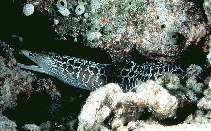| Family: |
Muraenidae (Moray eels), subfamily: Muraeninae |
| Max. size: |
150 cm TL (male/unsexed) |
| Environment: |
reef-associated; brackish; marine; depth range 0 - 110 m |
| Distribution: |
Indo-Pacific: Red Sea and East Africa, including Walters Shoal (Ref. 33390) and Persian Gulf (Ref. 68964) to French Polynesia, north to southern Japan and the Hawaiian Islands, south to the southern Great Barrier Reef. Eastern Central Pacific: Costa Rica and Panama (Ref. 9324). |
| Diagnosis: |
Dorsal spines (total): 0-0; Dorsal soft rays (total): 0-0; Anal spines: 0-0; Anal soft rays: 0-0; Vertebrae: 126-138. Distinctive pattern of light undulating lines and speckles on a dark green background. Snout often yellow (Ref. 30404).
Description: Characterized by body depth at gill opening 12-21 in TL; origin of dorsal fin anterior to gill opening; anus at or slightly anterior to middle of body; long canine teeth anteriorly in jaws, some alternating with smaller teeth; front of upper jaw with three very long canines in median row; few inner canines on side of upper jaw in smaller specimens (Ref. 90102). |
| Biology: |
A common species on reef flats among rocks, rubble, or debris and also occurs in lagoons and seaward reefs to depths of 26 m or more. Minimum depth reported taken from Ref. 86942. Cavernicolous (Ref. 8593, 58302). Benthic (Ref. 58302). Nocturnal species that feeds on fishes, octopi, and probably crustaceans. Reported to be an aggressive species and prone to bite. Used in Chinese medicine (Ref. 12166). |
| IUCN Red List Status: |
Least Concern (LC); Date assessed: 18 August 2011 Ref. (130435)
|
| Threat to humans: |
reports of ciguatera poisoning |
Source and more info: www.fishbase.org. For personal, classroom, and other internal use only. Not for publication.

